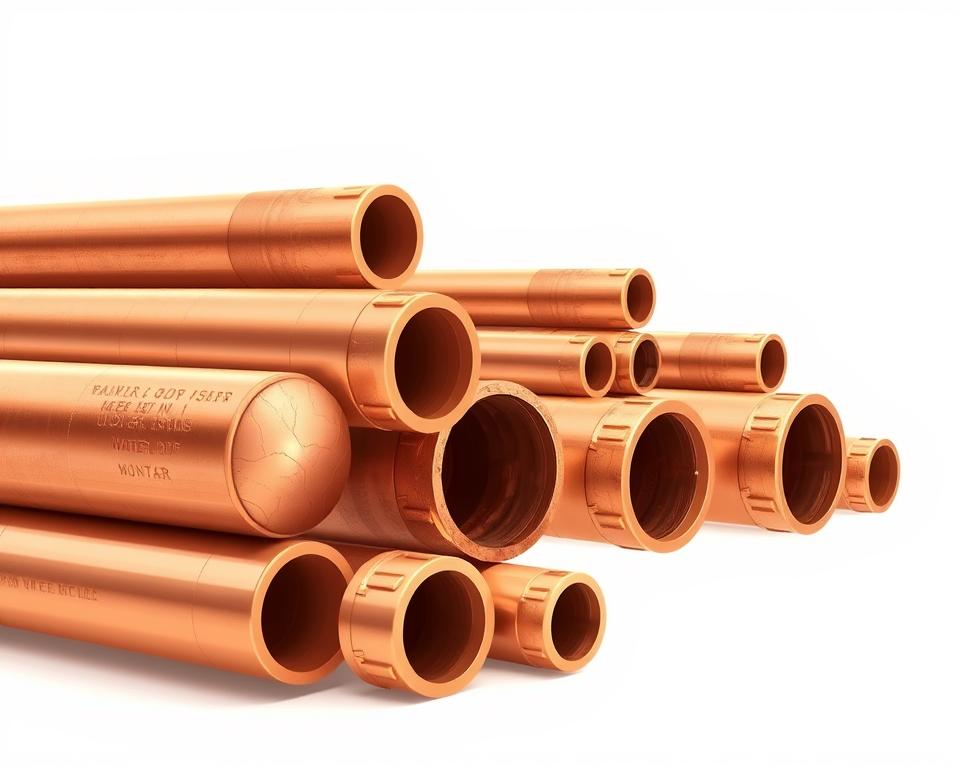Guide to Copper Pipe Water Line Sizes for Your Home
Did you realize that almost 30% of household plumbing problems are caused by pipes of the wrong size? Using the proper dimensions helps maintain ideal water pressure and system efficiency. Here’s a homeowner’s primer on the sizing essentials for residential water projects.
Proper sizing depends on factors like flow requirements and wall thickness. Standard 3/8″ copper tubing sizes run between 1/4″ and 8″ across, noted by NPS versus actual exterior measurements. Installation Parts Supply offers expert guidance to match your home’s needs with compliant solutions.
Copper continues leading the pack because of its strength and ability to resist corrosion. Whether retrofitting your setup or installing from scratch, knowing these principles cuts downtime and avoids costly mishaps.
Major Highlights

- Correct sizing prevents 30% of common plumbing problems
- Common sizes run between 1/4″ and 8″
- NPS measurements differ from actual outer dimensions
- Correct sizing upholds pressure and system efficiency
- Copper delivers strength and rust protection
- Specialist support secures regulation adherence
Reasons to Select Copper for Your Plumbing
Long-lasting plumbing begins by choosing the proper material—copper excels for these reasons. With over 50 years of service life and NSF drinking-water approval, it’s a favorite among homeowners. It uniquely blends durability with environmental responsibility.
Toughness and Rust Protection
Resisting rust and chemicals by nature, copper outlasts PVC and PEX. Smooth bore reduces friction, keeping water pressure steady. Real-world examples show installations lasting decades without leaks.
Installation Parts Supply carries certified quality products suited to your project. While initial costs are higher, the long-term savings from fewer repairs justify the investment.
Flexibility and Freeze Protection
In frost-prone areas, its minor freeze expansion helps avert pipe bursts. This flexibility reduces the risk of costly winter damage. Combine with adequate insulation to optimize freeze defense.
Sustainable and Germ-Fighting Properties
Copper is 100% recyclable, reducing environmental impact. Antimicrobial action curbs bacterial proliferation to boost water purity. Green-minded homeowners prefer it to plastic options.
Mastering Copper Water Line Measurements and Styles
Many homeowners struggle with pipe sizes—let’s break it down. The industry uses Nominal Pipe Size (NPS), which doesn’t match the actual outer dimensions. For example, a 1/2″ NPS has an outer diameter of 0.625″.
Labeled vs. True Pipe Sizes
NPS figures serve as tags, not precise sizes. Always check the outer diameter (OD) before purchasing. Use this quick conversion guide:
- 1/4″ nominal → 0.375″ actual
- 1/2″ nominal → 0.625″ actual
- 3/4″ nominal → 0.875″ actual
L vs. M vs. K Copper Pipes
Three copper variants lead in home plumbing. Their wall thickness determines strength and use cases:
- Type L: Light-wall (0.040″ for 1/2″), ideal for most homes.
- Type M: Mid-wall (0.050″ @ 1/2″), cost-effective yet durable.
- Type K: Thick-wall (0.060″ @ 1/2″), meant for high-pressure use.
For versatility, Installation Parts Supply favors Type M in most setups. Larger diameters (over 2″) often require Type K for irrigation or commercial use.
Type L Copper Pipes: Thin-Wall Versatility
DIY enthusiasts benefit from L-type’s superior bendability. Its thin-wall construction reduces weight and cost while maintaining reliability. Comes both in straight bars and flexible coils for HVAC to DWV work.
Common Applications and Limitations
It’s perfect for low-PSI situations. Its 0.040″ wall thickness makes it ideal for:
- HVAC refrigerant lines
- Drain-waste-vent (DWV) systems
- Residential water supply (below 80 PSI)
High-pressure? Skip L-type and choose K-type instead. Up to 50ft flexible coils hug corners, though bending must be gentle to prevent pinches.
Sizing Options and Installation Tips
Choose from 1/4″ to 8″ diameters, with these popular options:
| Form | Max Length | Best For |
|---|---|---|
| Rigid | 20ft | Straight runs |
| Coiled | 50ft | Tight spaces |
Installation Parts Supply recommends rigid forms for beginners—they’re easier to cut and solder. For large projects, coiled options reduce joint counts, saving time and potential leak points.
Type M Copper Pipes: The Residential Standard
With cost and strength balanced, M-type is ideal for today’s residences. A mid-thickness wall manages daily use without breaking the bank. Approved by NSF for water and gas, it works in kitchens, baths, and heating.
Where M-Type Shines
This type excels in hot and cold supply lines, maintaining steady water pressure. Use 12ft rigid for long stretches, 100ft coils for narrow pathways. Common applications include:
- Drinking water distribution
- Medical gas lines (oxygen, nitrous oxide)
- HVAC refrigerant lines
Thickness vs. Pressure for M-Type
It balances the characteristics of L and K. 0.050″ thickness (1/2″) withstands pressures up to 150 PSI. See the specs contrast:
| Type | Wall Thickness (1/2″) | Max Pressure | Best For |
|---|---|---|---|
| L | 0.040″ | 80 PSI | Low-pressure DWV |
| M | 0.050″ | 150 PSI | Residential supply |
| K | 0.060″ | 200 PSI | Irrigation |
Find M-type in every common size at Installation Parts Supply. Use flare fittings on gas runs to avoid leaks. Include minimal expansion spacing in hot piping for thermal growth.
Type K Copper Pipes: Heavy-Duty Performance
When durability matters most, K-type delivers unmatched strength for demanding projects. Heavy walls plus high PSI capacity suit it to industrial or buried lines. It withstands both compression and corrosion better than lighter gauges.
Heavy-Duty Use Cases
K-type thrives in extreme conditions. Its 0.060″ wall thickness (for 1/2″ NPS) handles up to 200 PSI, perfect for:
- Underground irrigation systems
- Commercial HVAC refrigerant lines
- Fire sprinkler networks
Installation Parts Supply advises an 18″ burial depth for underground runs. Use compression connectors tightened to 25 ft·lb to seal joints.
How to Choose Rigid or Coiled K-Type
Choose the right form for your project. Rigid 12ft for long stretches; coils 50ft for complex paths. Here’s how they stack up:
| Form | Best For | Limitations |
|---|---|---|
| Rigid | High-pressure mains | Requires more fittings |
| Coiled | Trenchless installations | Risk of kinks if bent sharply |
For irrigation, design loops with 10% expansion gaps. Never bend rigid pipe by hand—use a bender or risk flow-reducing kinks.
Installing and Caring for Copper Pipes
Proper installation techniques ensure decades of leak-free performance in plumbing systems. Homeowners and contractors both gain by learning these key steps. Use these approaches for solid, durable joints.
Soldering vs. Compression vs. Push-Fit
Pick a method suited to your application. Use solder or compression for lasting joins; temporary fittings for flexibility. See which suits you best:
| Method | Pros | Cons | Best For |
|---|---|---|---|
| Soldering | Strong, permanent | Requires skill | Water supply lines |
| Compression | No heat needed | Bulky fittings | Tight spaces |
| Push-Fit | Quick installation | Higher cost | Emergency repairs |
How to Solder Copper Pipes
Achieve a perfect joint by doing this:
- Clean surfaces with emery cloth.
- Coat each piece evenly with flux.
- Heat until the flux bubbles.
- Touch solder to the fittings—capillary action draws it in.
Protective gloves and fresh air are a must. Installation Parts Supply stocks lead-free solder for drinking water safety.
Avoiding Drips and Freeze Breaks
Wrap pipes in unheated zones with foam sleeves. Install insulating sleeves on wall-penetrating sections. To fix minor issues:
- Look for greenish corrosion at joints each year.
- Support horizontal runs every 32 inches to prevent sagging.
- Choose freeze-safe taps in winter-prone areas.
A yearly review stops small leaks from worsening. Have essential tools on hand—wrenches, cutters, Teflon tape handle most jobs.
Wrapping Up: Choosing Copper Pipes
A well-planned system lasts decades—let’s wrap up with key takeaways. Choose proper size and type for lasting durability. Don’t forget:
- M-type works for most residences; K fits heavy-duty applications
- Right sizing ensures steady pressure and leak prevention
- Frost defense matters where it gets cold
Lean on Installation Parts Supply’s expertise to make selection easy. Certified solutions with quality warranties keep your plumbing systems running perfectly.
Looking for assistance? Get free sizing charts or book a consultation now. First-time buyers get exclusive discounts—start your project right!


